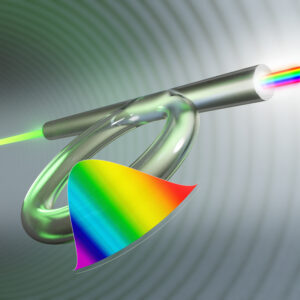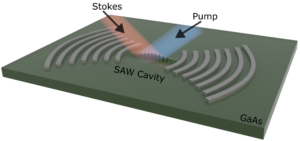Ultrashort pulses, Solitons, and Bio-Imaging
 Nature is nonlinear, which allows for complex and beautiful dynamics and patterns from turbulence and chaos to fractals and self-similarity. Nonlinear optical systems are relatively simple and therefore provide an ideal testbed to explore universal concepts in nonlinear pattern formation. One archetypal nonlinear pattern is the solitary-wave (or soliton), which is a wave-packet that propagates without change. In addition to its intrinsic interest, the soliton plays a major technological role in the generation of ultrashort (femtosecond) pulses from laser sources, demonstrating the impact possible from new discoveries in this field. Research in the group involves theoretical and experimental exploration of nonlinear optical processes in bulk, fiber, and nanophotonic systems. Stable patterns are applied towards applications like nonlinear imaging deep into the brain. See some of our recent work on chirped and stretched-pulse generation in Kerr resonators.
Nature is nonlinear, which allows for complex and beautiful dynamics and patterns from turbulence and chaos to fractals and self-similarity. Nonlinear optical systems are relatively simple and therefore provide an ideal testbed to explore universal concepts in nonlinear pattern formation. One archetypal nonlinear pattern is the solitary-wave (or soliton), which is a wave-packet that propagates without change. In addition to its intrinsic interest, the soliton plays a major technological role in the generation of ultrashort (femtosecond) pulses from laser sources, demonstrating the impact possible from new discoveries in this field. Research in the group involves theoretical and experimental exploration of nonlinear optical processes in bulk, fiber, and nanophotonic systems. Stable patterns are applied towards applications like nonlinear imaging deep into the brain. See some of our recent work on chirped and stretched-pulse generation in Kerr resonators.
Optomechanics in fiber and micro-structured waveguides
Brillouin scattering is a nonlinear optical  effect involving the interaction of light with sound. Studied since the early days of nonlinear optics, stimulated Brillouin scattering is one of the strongest nonlinear optical effects and has enabled technological advances for sensing, microwave processing, slow and fast light, high coherence source generation, and optical phase conjugation. Recent years have seen a surge of interest in a type of Brillouin scattering that occurs in systems where both light and sound are supported by a waveguide. This type of Brillouin scattering is highly tunable and is advantageous for microwave processing, tunable source generation, and ultrafast processing. Remarkably, new types of optomechanical interactions are still being discovered and explored as the field continues to grow. Our group is pushing this nonlinear optical frontier and also applying these interactions toward novel technologies. See our recent results on strong coupling to ultra-long lived phonons in tapers here and here.
effect involving the interaction of light with sound. Studied since the early days of nonlinear optics, stimulated Brillouin scattering is one of the strongest nonlinear optical effects and has enabled technological advances for sensing, microwave processing, slow and fast light, high coherence source generation, and optical phase conjugation. Recent years have seen a surge of interest in a type of Brillouin scattering that occurs in systems where both light and sound are supported by a waveguide. This type of Brillouin scattering is highly tunable and is advantageous for microwave processing, tunable source generation, and ultrafast processing. Remarkably, new types of optomechanical interactions are still being discovered and explored as the field continues to grow. Our group is pushing this nonlinear optical frontier and also applying these interactions toward novel technologies. See our recent results on strong coupling to ultra-long lived phonons in tapers here and here.
Traveling-wave optomechanics for quantum information control

At room temperature, the high frequency acoustic waves generated by Brillouin scattering rapidly decay into the environment. At cryogenic temperatures, these same phonons can last several orders of magnitude longer, which substantially enhances the interaction and enables a new world of photon-phonon dynamics. Much like the radiation pressure mediated interaction in cavity optomechanical systems, this electrostriction mediated traveling-wave optomechanical interaction enables a new platform for quantum information processing, ultrasensitive metrology, and fundamental tests of quantum decoherence. This Brillouin-like coupling provides optical access to ultra-long lived phonons in any transparent material, which is highly desirable for new technologies as well as for basic material science. The group is exploring new directions in traveling-wave optomechanics both theoretically and experimentally. See our recent results on surface acoustic waves here.
Optical Computing
 Artificial neural networks inspired by the massive processing of the brain can now be found across modern society in web searching, smartphones, and games. While incredibly effective, large neural networks are incompatible with traditional computers for which Moore’s law has hit physical limits, and memory accessing adds significant lag. Specialized dense-data-optimized processors such as GPUs surpass these bottlenecks, but consume considerable power. Optics, which has already demonstrated superiority for interconnection tasks, has been recognized as a great fit for today’s computing demands due to its ultra-low loss propagation, large accessible bandwidth, and lack of interference between neighboring channels. While recent optical neural network approaches have demonstrated useful fast and efficient calculations, scaling up in size to meet current demand represents a major challenge for the field. Our group is developing several approaches to overcome this challenge for large-scale, compact, efficient, and ultra-high speed optical computing.
Artificial neural networks inspired by the massive processing of the brain can now be found across modern society in web searching, smartphones, and games. While incredibly effective, large neural networks are incompatible with traditional computers for which Moore’s law has hit physical limits, and memory accessing adds significant lag. Specialized dense-data-optimized processors such as GPUs surpass these bottlenecks, but consume considerable power. Optics, which has already demonstrated superiority for interconnection tasks, has been recognized as a great fit for today’s computing demands due to its ultra-low loss propagation, large accessible bandwidth, and lack of interference between neighboring channels. While recent optical neural network approaches have demonstrated useful fast and efficient calculations, scaling up in size to meet current demand represents a major challenge for the field. Our group is developing several approaches to overcome this challenge for large-scale, compact, efficient, and ultra-high speed optical computing.
